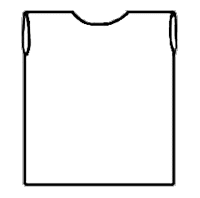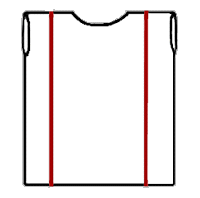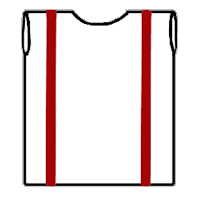
TWO PLACES AT ONCE
Clothing

In Ancient Rome, clothing was to exhibit their statuses, especially in men. In Roman fashion, the more significant the person was, their clothing would be unmistakeably marked, while the lower class would usually wear plain clothes. Women’s clothing was not relatively different to the men from the slight discrepancy in fabric. Their styles were quite undemanding so their hairstyle and jewellery were emphasized to show their class.
MEN
Men in Pompeii predominately wore linen tunics. A tunic is made of short wool stitched together on the sides of the tunic and on the shoulders. It is additionally created so that the tunic is just past the knees and cut at the sleeves so it becomes short sleeved. Men of wealth wore tunics with thin stripes in the colour of a deep crimson, which Ancient romans called purple. Tunics with thick stripes were additionally designed for politicians. For lower classed men, their tunics would be made of rougher and darker wool and they usually shortened their tunics for more convenient movement. Slaves who were men, inevitably dressed in the poorest clothing.

BASIC TUNIC

EQUESTRIAN TUNIC

SENATORIAL TUNIC
WOMEN
The Peplos
The peplos was quite simple that only consisted of two rectangular pieces of clothing stitched together on the sides. At the top of this dress, two open sections can be found which were folded down at the front and the back. Roman women then used two pins to secure the dress on their shoulders creating a sleeveless dress. In order to make the peplos more stylish, women fastened a belt around the waist under the folds.



The Chiton
The most costmary women clothing were similar to the Greek chiton. Two squared pieces of fabric were stitched together to the top, leaving enough rooms for the arms to go through. Women then stabilized the piece of clothing over the shoulders and arms by using large pins or buttons. This transformed the piece of garment into a dress with sleeves which would be then belted at either the waist, hips or under the breast. The chiton would usually be found in bright colours or light fabric, such as silk
The Stola
When women marry, they were a type of clothing called the Stola. This was a lengthy and sleeveless tunic, or would be help by thin straps at the shoulders, which was a layer above another garment. The Stola was predominately undyed and a colourless white. This type of dress was to represent marriage in the Ancient Pompeii and to marry; you would have to wear the Stola as it is under Roman law. The Stola was also how women indicated their respect for tradition.
The Stola was usually dressed with a drape of fabric called a palla. This clothing would be hung over the left shoulder, under the right arm, across the body and thrown toward the back. Another method would be to additionally drape the piece of clothing above so it would couver the head. This palla was commonly used for more prosperous women to demonstrate their elegance.


Hairstyles
Roman women depended on their hairstyle to differentiate from others. Styles were determined by the wealthier and the middle class soon followed suit with the hairstyle, generating a regular trend. However, only the more fortunate afforded hairstyles as they needed mirror which were only made of bronze or silver.


Jewellery
Upper classed women were able to afford a reasonable amount of jewellery while the less fortunate were unable to acquire jewellery. A jewellery design that lasted through the times on Ancient Pompeii was known as a fibula. This was a pin that had a similar appearance to a safety pin and was generally decorated in to an appealing and detailed look. Considering that Roman women usually pinned their dresses, many wore of rich pins with comprehensive engravings. However, other jewellery women fashioned included necklaces, pendants, bracelets, earrings, rings of gold, and gems. The most favoured jewellery in Ancient Pompeii was actually pearls constructed into bracelets, necklaces and earrings and was found to be evidently invented by the Ancient Romans. Nonetheless, silver and gold pearls were extremely expensive with only the wealthiest in Pompeii to be able to afford such richness. Pendants represented big events such as marriage or a new emperor and painting of women consistently included a number of costly jewellery.

